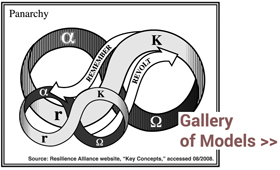“Resilience and transformability are not ‘opposites,'” cautioned Brian Walker at the Resilience 2011 conference. “They are compatible aspects of a complex adaptive system that functions at multiple scales” (video and slides).
I think of resilience-and-transformation as a duality: each defined in relation to the other, and together comprising a whole. As systems thinking can be understood as both systemic-and-systematic or as including both analysis-and-synthesis, resilience thinking includes both system resilience and system transformation.
Skillfully navigating this duality is one of the strengths of Bruce Goldstein’s 2012 edited volume, Collaborative Resilience: Moving Through Crisis to Opportunity.
From chapter 15, his “Conclusion: Communicative Resilience”:
[T]he dynamics of a bouncing ball and a society in crisis are not the same. The concept of social-ecological resilience developed in Collaborative Resilience addresses these differences by providing a less deterministic and more creative definition of a system’s capacity to absorb disturbance and reorganize while undergoing change. This definition is intentionally not a conservative one of “bouncing back”; it emphasizes that resilient systems can adapt or transform. …
Just as social-ecological resilience was deliberately not termed socio-ecological resilience so as not to imply that the social was a subordinate modifier of the ecological, communicative resilience not just a method for achieving resilience through collaboration. Instead, it is a framework for communities to both define and pursue resilience through collaborative dialog, rather than solely through expert analysis. A resilient system emerges as participants debate and define ecological and social features of the system and appropriate scales of activity. Poised between collaborative practice and resilience analysis, communicative resilience is both a process and an outcome of collective engagement with social-ecological complexity. …
Communicative resilience goes beyond suggesting that joint fact-finding and collective sensemaking can help a community better understand social-ecological relationships. It suggests that the system does not preexist the collaborative, which draws on diverse knowledge practices and storytelling to define it, their place in it, and its preferred condition. It is a coproductive dynamic, as system conditions are determined and reshaped through collaborative interaction.
See also:
“The co-production of science and society”
Collaborative Resilience book review at Ecology and Society


Nice post, thanks
Thanks, Ray!